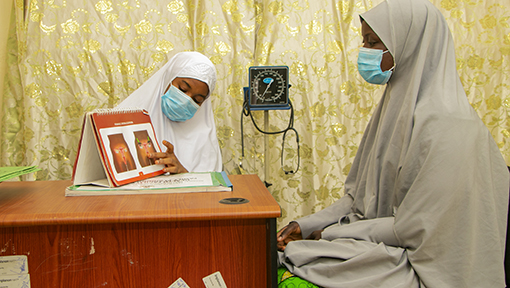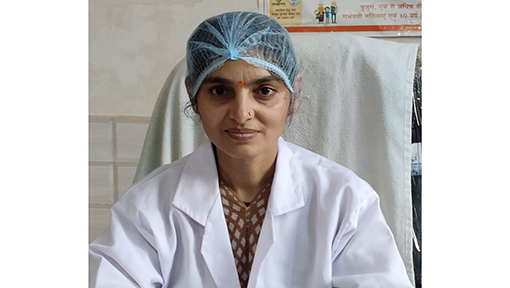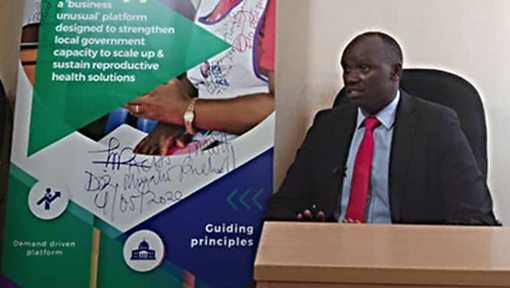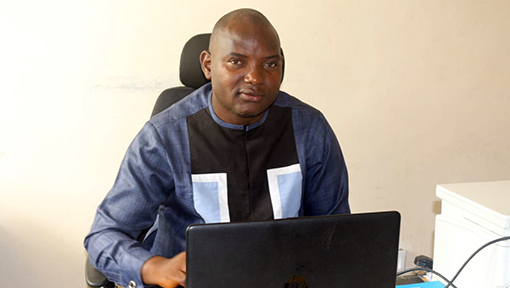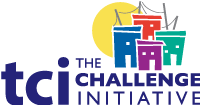In Their Own Words: Using Data for Decision-Making in Bareilly Helps TCIHC Accelerate Work

Suritesh Dagur (left), TCIHC’s City Manager in Bareilly, with the rest of the TCIHC team in front of the Chief Medical Officer’s office.
Suritesh Dagur serves as city manager for The Challenge Initiative for Healthy Cities (TCIHC) in Bareilly, the eighth largest city in Uttar Pradesh. Before transferring to Bareilly, she worked with the government of Saharanpur – one of the first five TCIHC cities – to scale-up TCIHC’s proven interventions. Below, she reflects on what she learned from her work in Saharanpur and how she used those learnings to make progress in her new TCIHC city of Bareilly.
My story goes back to the time when I had joined TCIHC as the City Manager of Saharanpur. After working for a year in this city known for its wood carving, I had managed to accelerate the uptake of family planning solutions in its urban primary health centers (UPHCs). But, my success story in Saharanpur took a twist when I was transferred to Bareilly – a new TCIHC city in Uttar Pradesh. This sudden transformation brought back the same feeling I had when I joined Saharanpur a year ago. I felt I was at ground-zero again, but I also sensed responsibility and high expectation for myself. I wanted to replicate the success of Saharanpur in Bareilly. I reflected back on my experience in Saharanpur, and I realized that I knew how the system works, the process and very well understood the way I had to move forward with my mission.”
As I landed in Bareilly, I felt an ‘air of indifference’ in the system as if everyone had accepted the way things were. Most of all I found that the system behaved differently from what I was used to in Saharanpur and people were not ready to accept TCIHC – which was the way in Saharanpur too at the beginning. I knew the best way to activate the system was to demonstrate a result that the health leadership of Bareilly had never achieved from urban areas until now. So, I started by getting orders for the special fixed day static service/family planning day (FDS/FDP) (also referred to locally as 30-hour magic +) for two facilities to coincide with World Population Day. The situation was not at all in our favor as supplies and instruments were missing from the UPHCs. I managed to arrange for the IUCDs kits and infection prevention equipment and instruments were borrowed from a private facility to give quality services to the clients. However, the biggest hurdle was untrained service providers as no staff nurse was trained on IUCD insertion in Bareilly. I ran around to get special orders from the Chief Medical Officer (CMO), who asked the facility Medical Officers to be on duty on the day of FDS. My team of field program assistants (FPAs) and field program coordinators (FPCs) worked hard in the field with the frontline workers [ASHAs and AWWs] to mobilize potential clients. The way we worked around the clock to make FDS a successful event was a shock to the system.”
On July 19, 2018, we had our first FDS in Bareilly at two facilities – UPHCs in Gher Zafar Khan and Subhash Nagar. It was like a fair. Twenty-seven clients voluntarily chose to get an IUCD inserted on this single day at both facilities. It was the largest number of IUCD accepters in an urban area of Bareilly to date. The results were shared with all the government officials. They were happy with the results, but the results were not enough to break the ice. Soon, FDS became a one-day wonder for the system.”
The high impact approach (HIA) tools helped me a great deal whenever I encountered a dilemma. I had used them many times in Saharanpur, but now it was time to do the same in Bareilly in order to get good results. Although the HIAs are very impactful at all engagements with stakeholders, the data for decision-making tool is one that can break the ice anywhere. The best part is that government already has data in its system through HMIS and other reports. Data comparison at any point of time (between the HMIS and project records) is a very good tool for any project as it is the only way by which the performance can be measured and helps inform decision-making as well. I used data for decision-making as an advocacy tool after the FDS and the results had poured in for FP uptake. I went to the office of the National Urban Health Mission (NUHM). Luckily, that day the NUHM Nodal Officer, Urban Health Coordinator and the City Community Process Manager (CCPM) were all in the office. I had made up my mind that today is the day when I will break the ice and present our project as their own necessity. I needed for them and the system to own the project. With this thought, I requested the Data Cum Accounts Assistant (DCAA) to share the file of monthly reports. DCAA had her apprehensions and did not comply with my request at first, instead she asked me to speak to the Nodal Urban Officer since she saw the data is proprietary and sensitive to those outside the system. I was prepared for this situation, so I spoke to the Nodal Urban Officer and convinced him that the only way to move forward with FP programming in the city was to analyze the data from HMIS. I explained to him that data is the only way by which we will be able to understand the situation right now and help the system in further planning for FP. The Nodal Urban Officer was convinced and directed the DCAA to provide the data.”
As expected, the HMIS data on family planning hadn’t been analyzed and whatever data that was submitted from the UPHCs were still in the hard copy. The DCAA had no clue as to whether correct reporting was being done or not. I analyzed the reports for June 2018 to July 2018 and prepared a presentation along with the excel sheet of the reports. The analysis showed many discrepancies, such as many UPHCs reporting PPIUCDs, which was actually being done at the District Women’s Hospital. Another major flaw was that the NUHM – which oversees the public health sector – was reporting services provided at the private facilities by their ASHAs in their own reports. These findings were compared to last year’s reports. The difference in the report that I prepared from the FDS versus what was being submitted by the UPHCs was eye opening for them.”
The NUHM team said that this is a really grave issue that the right reports are not coming in from the UPHCs. The Nodal Urban Officer asked me to ‘Kindly share the reports with us over email. The one which you have prepared is the right one. We want to understand the performance of UPHCs.’ The NUHM team also made a note that ‘data anomaly’ and wrong reporting were major issues to be discussed during the next review meeting.”
At this time, the Urban Health Coordinator said, ‘We never knew that the reports were wrong; I request you to kindly check the data of our UPHCs regularly. In fact, you can take the reports weekly from our facility and share with us, so that at the month end, we have the right report to be presented in our review.’ The moment he said this, I introduced TCIHC’s data for decision-making tool to him. I briefed him on how the specified indicators and steps mentioned in this tool help to monitor and do better activity planning. He was very impressed with the way TCIHC works, and immediately created a WhatsApp Group … to have correct FDS reports on the same day as they occur. This was the day when NUMH and the system recognized TCIHC’s value and better understood that we are here to help strengthen their system.”
Later, the Nodal Urban Officer and Urban Health Coordinator asked me to coach the pharmacists and medical officers of the UPHCs on how a report should be prepared. He further prepared a schedule of joint visits of CCPMs and FPCs to UPHCs so that the CCPMs can better understand the reports and how they are to be prepared correctly. This was the turning point for the TCIHC in Bareilly.”

